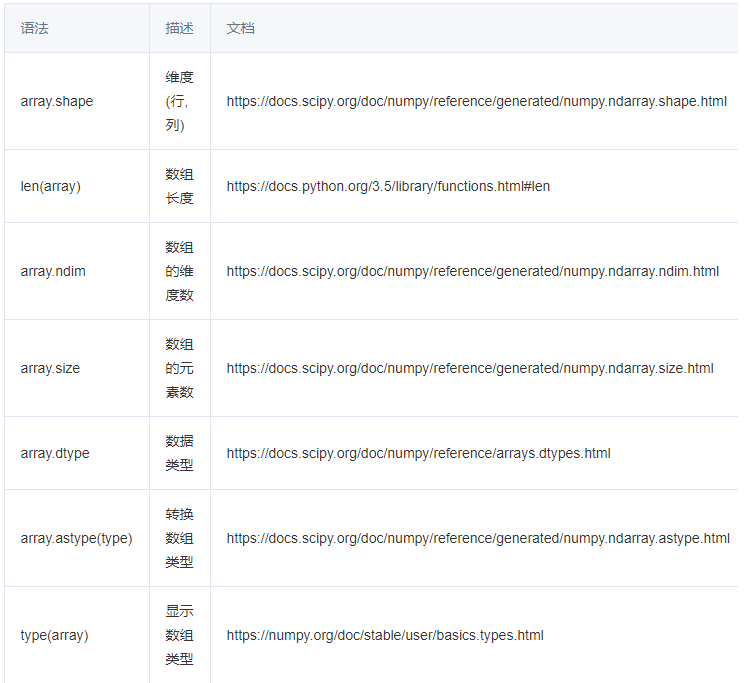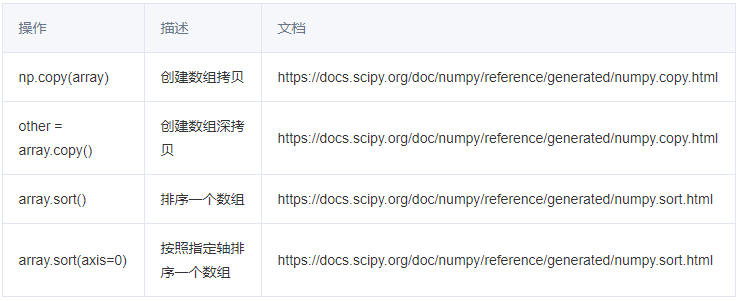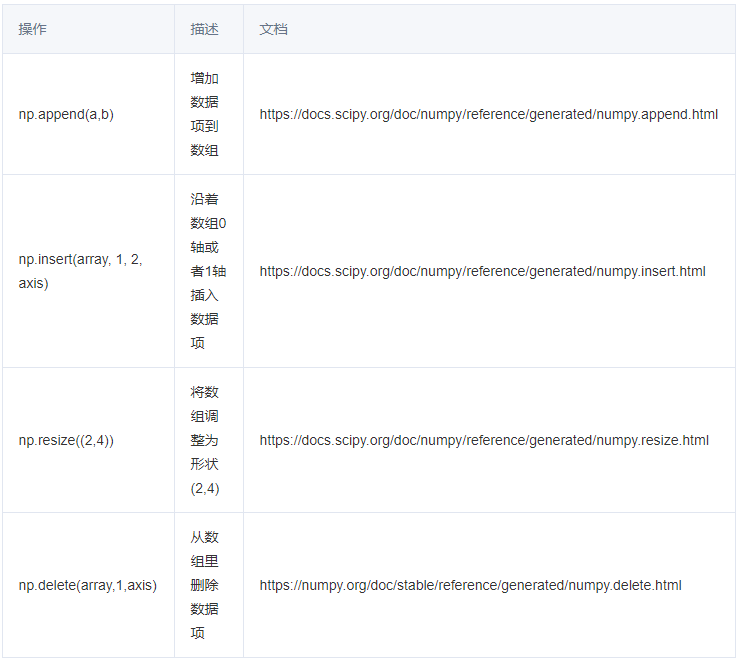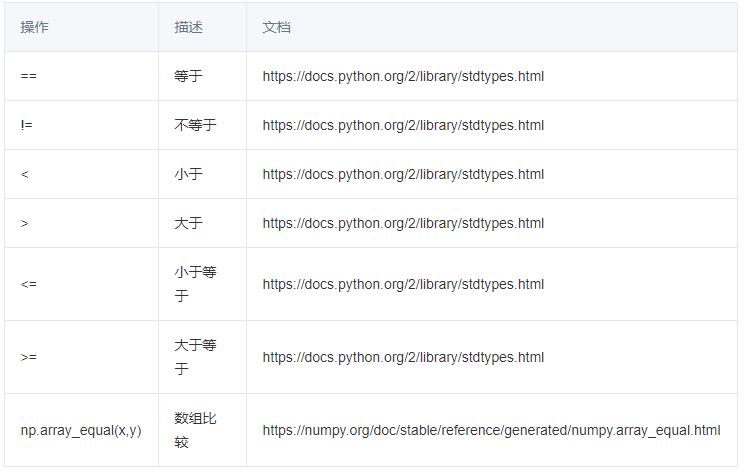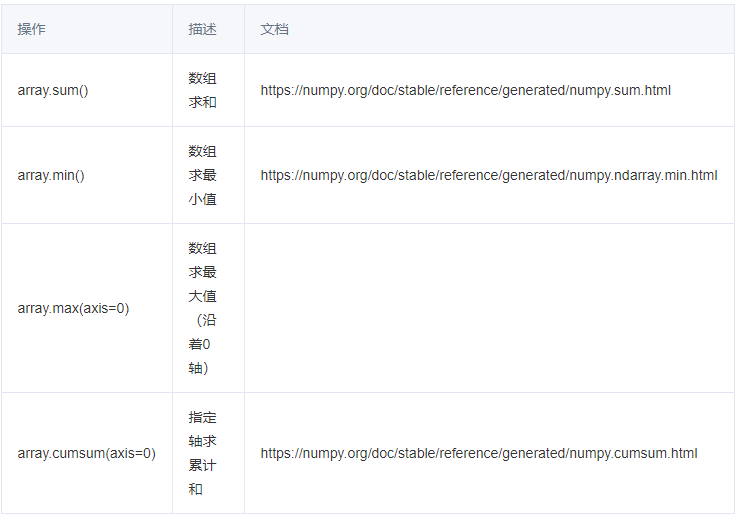Numpy核心语法和代码整理汇总!
点击上方“机器学习与生成对抗网络”,关注"星标"
获取有趣、好玩的前沿干货!
用户2769421 | 作者
腾讯云 云+社区 | 来源
文仅交流,侵删
Numpy是一个用python实现的科学计算的扩展程序库,包括:
一个强大的N维数组对象Array;
比较成熟的(广播)函数库;
用于整合C/C++和Fortran代码的工具包;
实用的线性代数、傅里叶变换和随机数生成函数。numpy和稀疏矩阵运算包scipy配合使用更加方便。
NumPy(Numeric Python)提供了许多高级的数值编程工具,如:矩阵数据类型、矢量处理,以及精密的运算库。专为进行严格的数字处理而产生。多为很多大型金融公司使用,以及核心的科学计算组织如:Lawrence Livermore,NASA用其处理一些本来使用C++,Fortran或Matlab等所做的任务。
本文整理了一个Numpy的小抄表,总结了Numpy的常用操作,可以收藏慢慢看。
(图片可以点开大图查看哦~)
1
安装Numpy
可以通过 Pip 或者 Anaconda安装Numpy:
$ pip install numpy或
$ conda install numpy2
基础
NumPy最常用的功能之一就是NumPy数组:列表和NumPy数组的最主要区别在于功能性和速度。
列表提供基本操作,但NumPy添加了FTTs、卷积、快速搜索、基本统计、线性代数、直方图等。
两者数据科学最重要的区别是能够用NumPy数组进行元素级计算。
axis 0:通常指行
axis 1:通常指列
1.占位符
举例:
import numpy as np
# 1 dimensional
x = np.array([1,2,3])
# 2 dimensional
y = np.array([(1,2,3),(4,5,6)])
x = np.arange(3)
>>> array([0, 1, 2])
y = np.arange(3.0)
>>> array([ 0., 1., 2.])
x = np.arange(3,7)
>>> array([3, 4, 5, 6])
y = np.arange(3,7,2)
>>> array([3, 5])2.数组属性
3.拷贝 /排序
举例:
import numpy as np
# Sort sorts in ascending order
y = np.array([10, 9, 8, 7, 6, 5, 4, 3, 2, 1])
y.sort()
print(y)
>>> [ 1 2 3 4 5 6 7 8 9 10]4.数组操作例程
增加或减少元素
举例:
import numpy as np
# Append items to array
a = np.array([(1, 2, 3),(4, 5, 6)])
b = np.append(a, [(7, 8, 9)])
print(b)
>>> [1 2 3 4 5 6 7 8 9]
# Remove index 2 from previous array
print(np.delete(b, 2))
>>> [1 2 4 5 6 7 8 9]组合数组
举例:
import numpy as np
a = np.array([1, 3, 5])
b = np.array([2, 4, 6])
# Stack two arrays row-wise
print(np.vstack((a,b)))
>>> [[1 3 5]
[2 4 6]]
# Stack two arrays column-wise
print(np.hstack((a,b)))
>>> [1 3 5 2 4 6]分割数组
举例:
# Split array into groups of ~3
a = np.array([1, 2, 3, 4, 5, 6, 7, 8])
print(np.array_split(a, 3))
>>> [array([1, 2, 3]), array([4, 5, 6]), array([7, 8])]数组形状变化
操作
其他
举例:
# Find inverse of a given matrix
>>> np.linalg.inv([[3,1],[2,4]])
array([[ 0.4, -0.1],
[-0.2, 0.3]])5.数学计算
操作
举例:
# If a 1d array is added to a 2d array (or the other way), NumPy
# chooses the array with smaller dimension and adds it to the one
# with bigger dimension
a = np.array([1, 2, 3])
b = np.array([(1, 2, 3), (4, 5, 6)])
print(np.add(a, b))
>>> [[2 4 6]
[5 7 9]]
# Example of np.roots
# Consider a polynomial function (x-1)^2 = x^2 - 2*x + 1
# Whose roots are 1,1
>>> np.roots([1,-2,1])
array([1., 1.])
# Similarly x^2 - 4 = 0 has roots as x=±2
>>> np.roots([1,0,-4])
array([-2., 2.])比较
举例:
# Using comparison operators will create boolean NumPy arrays
z = np.array([1, 2, 3, 4, 5, 6, 7, 8, 9, 10])
c = z < 6
print(c)
>>> [ True True True True True False False False False False]基本的统计
举例:
# Statistics of an array
a = np.array([1, 1, 2, 5, 8, 10, 11, 12])
# Standard deviation
print(np.std(a))
>>> 4.2938910093294167
# Median
print(np.median(a))
>>> 6.5更多
6.切片和子集
举例:
b = np.array([(1, 2, 3), (4, 5, 6)])
# The index *before* the comma refers to *rows*,
# the index *after* the comma refers to *columns*
print(b[0:1, 2])
>>> [3]
print(b[:len(b), 2])
>>> [3 6]
print(b[0, :])
>>> [1 2 3]
print(b[0, 2:])
>>> [3]
print(b[:, 0])
>>> [1 4]
c = np.array([(1, 2, 3), (4, 5, 6)])
d = c[1:2, 0:2]
print(d)
>>> [[4 5]]切片举例:
import numpy as np
a1 = np.arange(0, 6)
a2 = np.arange(10, 16)
a3 = np.arange(20, 26)
a4 = np.arange(30, 36)
a5 = np.arange(40, 46)
a6 = np.arange(50, 56)
a = np.vstack((a1, a2, a3, a4, a5, a6))生成矩阵和切片图示
7.小技巧
布尔索引
# Index trick when working with two np-arrays
a = np.array([1,2,3,6,1,4,1])
b = np.array([5,6,7,8,3,1,2])
# Only saves a at index where b == 1
other_a = a[b == 1]
#Saves every spot in a except at index where b != 1
other_other_a = a[b != 1]import numpy as np
x = np.array([4,6,8,1,2,6,9])
y = x > 5
print(x[y])
>>> [6 8 6 9]
# Even shorter
x = np.array([1, 2, 3, 4, 4, 35, 212, 5, 5, 6])
print(x[x < 5])
>>> [1 2 3 4 4]参考:
https://github.com/juliangaal/python-cheat-sheet
猜您喜欢:
超100篇!CVPR 2020最全GAN论文梳理汇总!
拆解组新的GAN:解耦表征MixNMatch
StarGAN第2版:多域多样性图像生成
附下载 | 《可解释的机器学习》中文版
附下载 |《TensorFlow 2.0 深度学习算法实战》
附下载 |《计算机视觉中的数学方法》分享
《基于深度学习的表面缺陷检测方法综述》
《零样本图像分类综述: 十年进展》
《基于深度神经网络的少样本学习综述》
![]()


